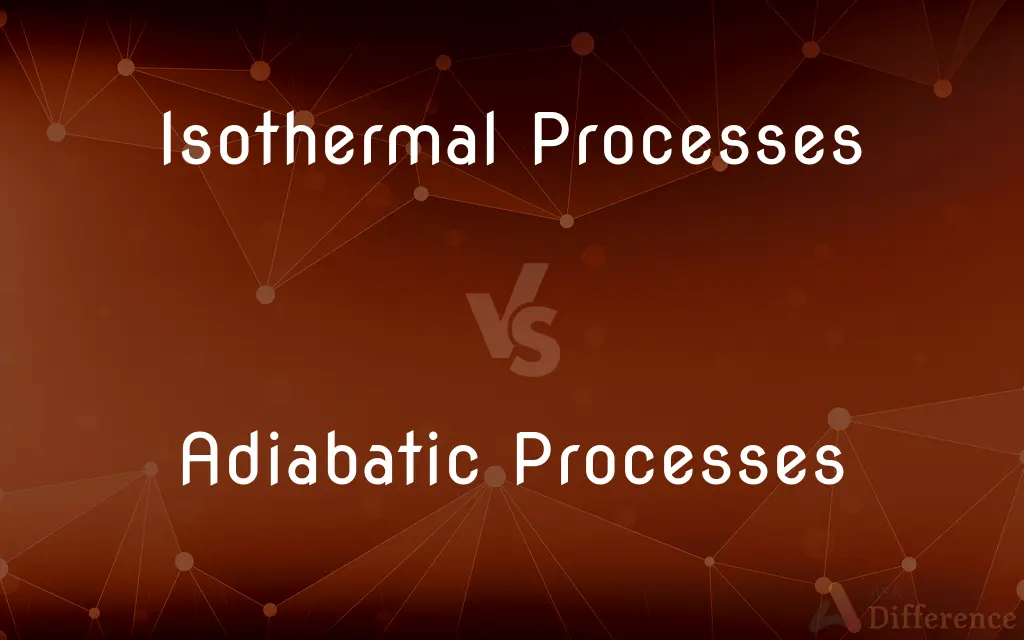Isothermal Processes vs. Adiabatic Processes — What's the Difference?
By Tayyaba Rehman — Published on January 11, 2024
Isothermal processes occur at a constant temperature, while adiabatic processes occur without heat transfer.

Difference Between Isothermal Processes and Adiabatic Processes
Table of Contents
ADVERTISEMENT
Key Differences
Isothermal processes involve a system where the temperature remains constant throughout the process. This means that any heat added or removed from the system is done so in a manner that maintains a steady temperature. The term "isothermal" comes from the Greek words "iso," meaning equal, and "thermos," meaning heat.
Adiabatic processes, in contrast, occur without any heat exchange between the system and its surroundings. In such a process, the system is perfectly insulated, meaning no heat is absorbed or released. The energy changes in the system are a result of work done by or on the system.
In an isothermal process, the energy entering or leaving a system as heat is compensated by work to keep the temperature static. For an ideal gas, this is described by the law PV = nRT, where P is pressure, V is volume, T is temperature, R is the gas constant, and n is the amount of substance.
During adiabatic processes, the energy of the system changes due to work, which results in a change in temperature. The process is characterized by the adiabatic equation PV^γ = constant, where γ (gamma) is the heat capacity ratio (Cp/Cv), and the other symbols have their usual meanings.
Although both processes are reversible in theory, in practical applications, there are always some losses due to friction or non-ideal conditions. The distinction is crucial in thermodynamics and is used to describe processes in engines, refrigerators, and even in atmospheric science.
ADVERTISEMENT
Comparison Chart
Temperature Change
No change in temperature.
Temperature changes.
Heat Transfer
Heat is transferred to maintain temperature.
No heat is transferred.
Energy Change
Due to work done by or on the system.
Due to work done by or on the system.
Equation
PV = nRT (for ideal gases).
PV^γ = constant (for ideal gases).
Practical Occurrence
In slow processes allowing heat exchange.
In rapid processes or with insulation.
Compare with Definitions
Isothermal Processes
A transition where the system's heat content is invariant.
The isothermal compression of a gas requires heat removal to keep the temperature unchanged.
Adiabatic Processes
A process with no heat exchange between system and surroundings.
A rapid compression of air in a cylinder is often treated as an adiabatic process.
Isothermal Processes
A process characterized by constant temperature dynamics.
Isothermal processes are ideal models for analyzing engine efficiency.
Adiabatic Processes
A dynamic transition without heat interaction.
In an adiabatic process, the insulation of the system is considered perfect.
Isothermal Processes
A process that occurs at a constant temperature.
Condensation of steam in a turbine can be approximated as an isothermal process.
Adiabatic Processes
An operation in thermodynamics that is heat isolated.
Adiabatic processes explain why rising air cools without heat loss to the environment.
Isothermal Processes
A thermodynamic change where temperature remains steady.
In an isothermal process, a gas expands while maintaining the same temperature.
Adiabatic Processes
A thermodynamic change that occurs without transferring heat.
The adiabatic cooling of air parcels leads to cloud formation in the atmosphere.
Isothermal Processes
A process maintaining equilibrium temperature during a reaction.
The isothermal processes in a heat bath ensure no temperature gradient in the material.
Adiabatic Processes
A process where total heat of the system is conserved.
As the piston moves, the adiabatic process causes the gas temperature to rise due to compression.
Common Curiosities
What defines an isothermal process?
An isothermal process occurs at constant temperature throughout.
Can isothermal processes occur naturally?
Yes, they can occur in slow, controlled systems that allow for heat exchange.
Do adiabatic processes always increase temperature?
Not always; temperature can increase or decrease, depending on whether the process involves compression or expansion.
What is an example of an adiabatic process?
Compression of gases in an insulated cylinder is adiabatic.
Are adiabatic processes more common than isothermal?
Adiabatic processes are common in fast or insulated systems, while isothermal processes require slow thermal equilibration.
Can isothermal processes result in a change in pressure?
Yes, while temperature remains constant, pressure can change in isothermal processes.
How do you identify an adiabatic process?
It can be identified by no heat exchange with the surroundings and can be tested by measuring temperature changes.
Why are isothermal processes important in engines?
They represent ideal processes that can help maximize efficiency.
What does γ represent in the adiabatic process equation?
It represents the heat capacity ratio (Cp/Cv) of the gas.
How is the temperature kept constant in an isothermal process?
Through the careful addition or removal of heat from the system.
Can isothermal processes be used in refrigeration?
Yes, refrigeration cycles rely on isothermal processes at the condenser and evaporator stages.
Is it possible for a process to be both isothermal and adiabatic?
In theory, yes, but in practice, this would require a system at absolute zero.
Does the adiabatic process violate the first law of thermodynamics?
No, the first law (conservation of energy) still applies; the internal energy changes due to work done on or by the system.
Are real-world processes perfectly isothermal or adiabatic?
No, real-world processes usually have some heat loss or gain, so they're not perfectly isothermal or adiabatic.
Does an adiabatic process have to be rapid?
While many adiabatic processes are rapid, the key factor is that there is no heat exchange, regardless of the speed of the process.
Share Your Discovery

Previous Comparison
Inline in C++ vs. Macro in C++
Next Comparison
AutoCAD vs. MicroStationAuthor Spotlight
Written by
Tayyaba RehmanTayyaba Rehman is a distinguished writer, currently serving as a primary contributor to askdifference.com. As a researcher in semantics and etymology, Tayyaba's passion for the complexity of languages and their distinctions has found a perfect home on the platform. Tayyaba delves into the intricacies of language, distinguishing between commonly confused words and phrases, thereby providing clarity for readers worldwide.












































